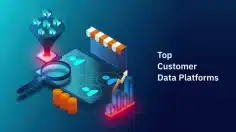How to create a customer journey map that drives conversions? (2024)
What is a customer journey map? And how to create a customer journey map? To understand this, let’s take an example. Recall the last time you shopped online.
Was it that you searched for something online and purchased it in one go? Well, not until and unless you have tried the product priorly.
You might have gone to several websites, checked out the products, read reviews, and then decided to make the purchase.
This is what a customer journey map is. Before a customer makes a purchase online, they have several interactions with a brand.
In this blog, we’re going to discuss customer journey maps and how to create an effective customer journey map.
We’ll also give you customer journey examples and customer journey templates that will further help to improve your understanding.
- What is a customer journey?
- What is the customer journey map?
- Why is customer journey mapping important?
- What are the components of a customer journey map?
- How to create a customer journey map?
- Best practices for customer journey mapping
- The conclusion
- How to create a customer journey map FAQs
Shortcuts:✂️
What is a customer journey?
Customer journey refers to the interactions that a customer has with a brand from awareness to the decision stage.
The customer journey starts from the point a customer becomes aware of a brand till the time they finally make the purchase.
However, remember that a customer journey doesn’t end after a customer has made the purchase.
Customer journey vs. buyer journey
Now, you must be wondering what’s the difference between the customer journey and the buying journey.
The buying journey refers to the process of a customer coming to the purchase stage while the customer journey refers to a customer’s purchasing experience with a brand.
Well, a buyer doesn’t suddenly go to a website and make a purchase immediately. First, they consider their options, compare them, and then decide to make a purchase.
Customer journey stages
As you are aware customers go through several stages before making the purchase decision. In this section, we will discuss each customer journey stage in detail.
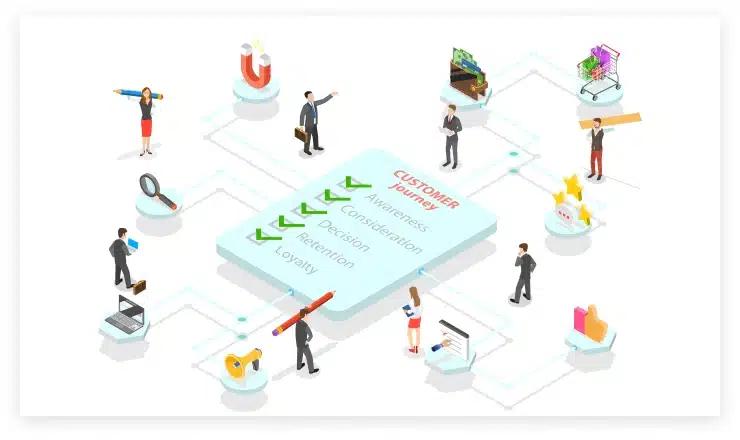
1. Awareness stage
The awareness stage is the one in which a customer becomes aware of a brand. This is the first time when they realize they have a problem and they need to find a solution.
At this time they start searching for brands that offer solutions to their problem. For this customer journey stage, brands should create informational and educational content.
The content that you can create for the awareness stage is blogs, guides, ebooks, and free courses. Through your content, you can tell people how your product can help solve their problems.
2. Consideration stage
This is the stage where customers are aware of the brands available in the market. Now, they are comparing brands to find the best option for them.
For this stage, brands should provide information to customers about how and why their products or services are better than others.
You can use different types of content like product comparison guides, charts, or case studies in this stage.
3. Decision stage
In this stage, customers are on the verge of making the purchase decision. They are ready to choose a brand among the available solutions.
You can use free consultations, demos, and customer testimonials to make customers confident in their purchase.
4. Retention stage
This is the post-purchase stage in which customers have already purchased your product and they decide to stay with your brand.
For retaining customers it’s important to provide a good experience. You should ensure the smooth onboarding of customers.
Just getting customers is not enough you should make sure that they don’t face any problems afterwards as well.
You should provide robust support and quickly resolve customer concerns. This leads to a positive experience and makes customers return to a brand.
5. Loyalty stage
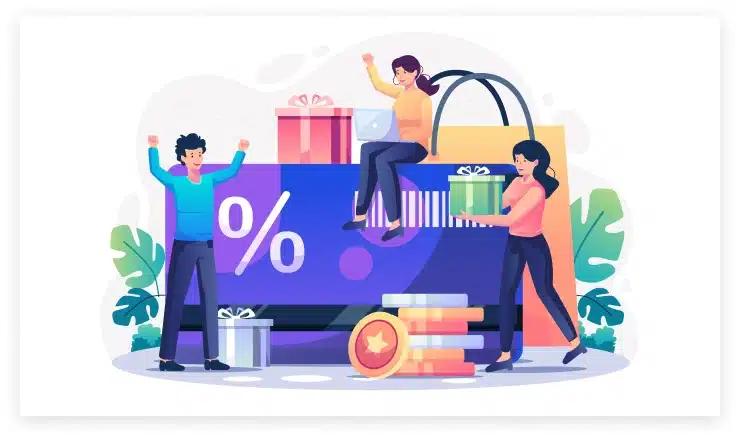
The loyalty stage is when a customer keeps choosing a brand over its competitors. Not only this, they actively promote the brand to their family and friends.
To build a loyal customer base, brands need to offer an exceptional customer experience. This includes everything from your website to social media and product performance.
You can also set up a customer loyalty program and reward customers for their valuable actions. This will encourage them to stay with your brand in the long run.
WebMaxy eGrowth lets you set up a customer loyalty program on your website. You can choose ways to reward customers and customize the theme according to your brand.
What is the customer journey map?
A customer journey map elaborates on the different stages that a customer goes through with a brand. It highlights what a customer is thinking at different points of their journey.
Mapping the customer journey can help brands enhance customer experience, boost conversions, and increase customer loyalty.
A customer journey map includes different touchpoints and the potential customer feelings. It includes the timeline of events like when a customer first visited your website, took a demo, and finally made the purchase.
A customer journey map template differs based on the products or services of a brand. You can also interview customers and know the distinct phases through which a customer goes through before making a purchase.
By understanding your customer journey map, you can get insights that help improve your customer journey significantly.
Why is customer journey mapping important?
The customer journey mapping process helps brands see their products or services from a customer’s perspective.
They can identify the routes and channels that help customers reach their product. There are many benefits of mapping customer journey that we have mentioned below.
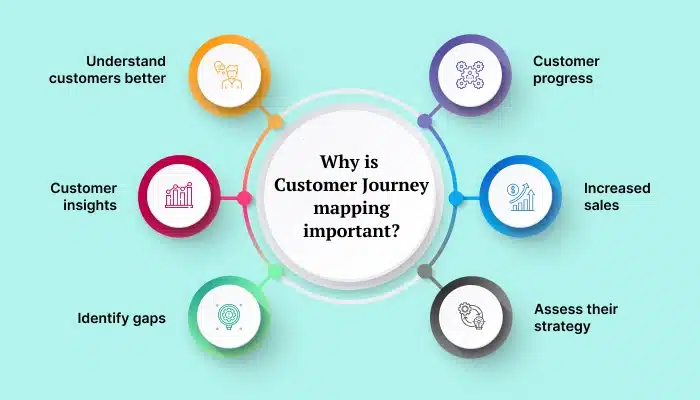
1. Understand customers better
Mapping customer journeys can help businesses track how customers move through the different stages.
They can understand the behavior of customers at every stage. This information will help them forecast which customers are more likely to convert.
2. Customer insights
A customer map journey provides insights into every stage that a customer goes through. Brands can find out the best ways to interact with customers.
They can determine the right content that can help them influence customers at each stage. For example, if most customers get stuck at the decision stage then they can consider offering a free trial.
3. Identify gaps
The customer journey mapping will help you identify gaps and loopholes in the customer experience.
For example, you can find out if customers are getting a coherent experience when they move from social media to your website.
4. Customer progress
By mapping the customer journey, you can find out how many customers move from the awareness to the decision-making stage.
This way you’ll be able to understand how many people you need to make aware in order to get your desired sales.
5. Increased sales
You can improve the customer experience by making strategic changes with customer journey mapping.
You can refine customer experience from the first to the last stage of the journey. This will help you to convert prospects into customers effortlessly.
6. Assess their strategy
Businesses can evaluate their performance against the industry standards by mapping out the customer journey. They can find out if the changes are working out for them or not.
What are the components of a customer journey map?
Customer journey mapping is important to identify gaps and improve customer experience. As per statistics, over 50% of people will switch to a competitor after an unsatisfactory experience. Thus, customer journey marketing is essential for brands.
In this section, we will discuss in detail about the components of a customer journey map. This information will help you do customer journey mapping easily.
1. Customer journey stages
How to create a customer journey map? Before creating a customer journey map, you need to identify stages in the customer journey of your brand.
For most of the brands, the customer journey stages are almost the same i.e. awareness, consideration, decision, and retention.
2. Buyer personas
A buyer persona is a representation of the customers of your brand. You can create different buyer personas depending on your target audience.
Buyer personas can help you predict customers’ behaviors and feelings. You can make customer journey maps easily.
3. Touchpoints
Touchpoints are the channels that customers use to connect with a brand before they make a purchase.
For example, if a customer is facing a technical problem, they will call customer support to help them out.
4. Emotions
When a customer plans to make a purchase it is often because they’re facing a problem and want to find a solution.
You should understand that there might be feelings of frustration, excitement, and worry. The main purpose of creating a customer journey map is to understand and pinpoint the customer pain points.
5. Opportunities
Once you have mapped out the customer journey, you can identify opportunities. You can see where there is scope for improvement and how you can go about it.
You can discover where most customers get stuck in their journey and what makes customers come back to your business.
How to create a customer journey map?
A customer journey map is crucial for marketing teams as it helps them know how to target customers at different buying journey stages.
A customer journey begins the moment a customer becomes aware of a brand. Later, they get interested in the offerings and become a customer.
Below, we have given the steps that you must follow to create a customer journey map.
1. Define your goals
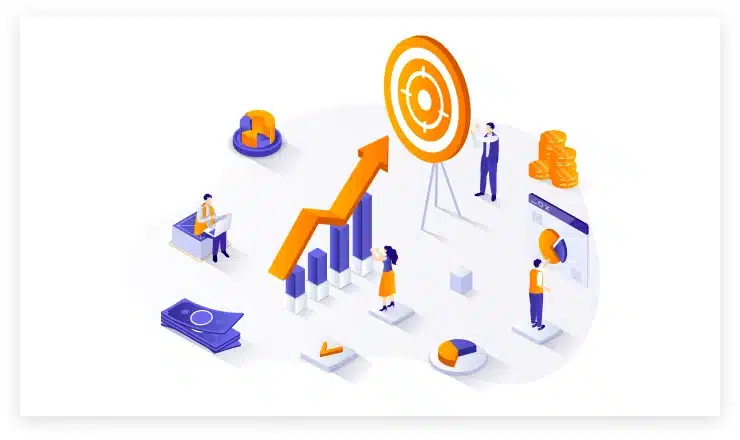
How to create customer journey map? To start with, you must define your goals. Determine what you want to achieve by mapping the customer journey.
For example, if you aim to enhance the overall customer experience with your brand then you need to consider all the touchpoints.
You need to ensure your website’s UI/UX is good and the support team replies to customer queries quickly.
2. Collect information
Now, it’s time to collect information and understand your customers better. You should find out which platforms customers use to engage with your brand. How do they interact with your brand and for how long?
You need to conduct market research to find answers to these questions. See what are the triggering points which make customers leave or convert.
Remember, when a customer opts for a product they also have certain expectations. If you aren’t able to meet those expectations they might leave your brand and won’t choose you again.
You should ensure that you set the right customer expectations. Create buyer personas to understand what your customers need, want, and expect. This way you’ll able to set the right customer expectations and try to meet their needs.
Talk to your existing customers and take surveys to find out what they think and feel about your brand. Gaining a deep understanding of customers can help you improve the service you deliver to customers.
3. Identify touchpoints
Customers can come across your brand through search engines, social media, ads, emails, blogs, etc. You need to identify the potential touchpoints from where customers become aware of your brand.
Not only this, you need to find out the channels through which customers connect with your brand when they face a problem. You need to ensure that it’s easy for them to connect with you.
According to statistics, 93% of customers are likely to make repeat purchases from brands that offer good customer support. You should ensure that your customer support is quick to reply to customer queries.
Omnichannel Support by WebMaxy can help you manage a large volume of customer queries efficiently. You can get access to customer queries from different channels in one dashboard.
4. Stages of customer experience
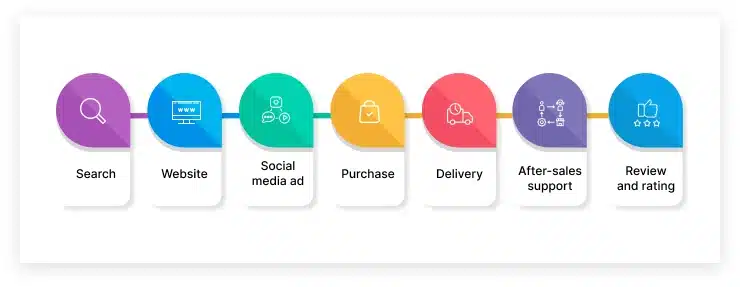
How to map a customer journey? Now, it’s time to map out your customer journey. Identify the events that occur when a customer interacts with your brand.
For example, a customer searches for a solution to their problem online. Next, they find your brand and go to your website. They check out a few web pages about the product and leave before making the purchase.
Then, while using social media, they see your ad. This time they finally decide to make the purchase and the product is delivered to them after a few days.
Next, your after-sales support team reaches out to them and asks them about their experience. They are happy with their purchase and they give a 5-star rating online.
Customer journeys vary based on the product or service. The journey taken by a customer to buy jewelry varies significantly from someone who’s taking a service subscription. Therefore, you should only consider the stages through which your customers go through.
5. Choose the right diagram type
How to create a customer journey map? Now it’s finally time to draw your customer journey map. The best way to create the customer journey map is swim lane diagrams.
You can create a map from the first stage of the journey when a customer becomes aware of a brand to the point when they write a review for your product.
From this map, you’ll be able to understand the points where you need to improve your service. However, there are many different ways that you can use to create your user journey map template such as a timeline, affinity diagram, a circular representation, and so on.
If you find mapping customer journeys difficult then you can use digital mapping tools like Touchpoint dashboard, UXPressia, Bamboobox, ClickUp, etc.
6. Analyze your map
You should make sure that your customer journey map is accurate. You can interview customers and take feedback from focus groups.
Now, it’s time to analyze the customer experience map. You should see if you are providing enough information to customers at different stages of the customer journey.
It’s also important to ensure that you’re providing the right information to customers at the right time. See if it’s easy for customers to connect with your brand at each touch point.
Best practices for customer journey mapping
How to create a customer journey map? We answered your this question above. Now, it’s time to learn about the best practices that can help improve your customer journey mapping.
1. Take customer surveys
Making a customer journey map based on assumptions will not help your brand in the long run. To begin customer journey mapping, you should interview your customers and ask them about their experience.
You can set up customer surveys and ask questions like:
- From where did you get to know about our brand?
- What do you like the most about our service?
- How would you rate our customer support service?
- How likely are you to recommend our brand to your friends or family?
The answers to these questions will help you get accurate information about your customer’s journey. You can identify the scope of improvement in the customer journey map.
2. Ask your customer service about the frequently asked questions
Your support representatives are the ones that are in direct contact with customers. They are aware of the customer’s pain points.
You can ask your support representatives about the issues that customers face the most. Inquire which questions are commonly asked by customers.
This analysis will help you know the information that you must include in your messaging. By doing this, you’ll be able to reduce the volume of customer queries and improve customer experience.
3. Create a customer journey map for each buyer persona
Every business has different types of buyer personas. Just creating a single customer journey map for all buyer personas will not help you precisely understand the customer journey.
Several factors play an important role in determining how a person interacts with your business and how they make purchases.
Therefore, you must create a customer journey map for each buyer persona. This will help you to understand customers better and target them with the right messaging.
For example, a brand like Bournvita has two major buyer personas i.e. parents and children. To target parents they need to talk about the nutritional value of the product and for children they need to convey how the product tastes good.
4. Update your customer journey maps
You can’t keep using that 2-year-old customer journey map forever. You must update your customer journey maps after every major change.
For example, if you start running ads for abandoned carts then your customer journey maps would change.
Also, it’s important to review your customer journey maps after every change. This will help you know if you are getting any value from the change or not.
5. Make customer journey maps accessible to every team
The customer journey maps are helpful not just for the marketing and sales team but for the entire business.
You should make customer journey maps accessible to everyone on the team so that they can provide feedback.
This will also ensure that teams keep the customer journey map in mind every time they create a strategy or make any changes.
The Conclusion
How to create a customer journey map? In the above blog, you learned about how to create a customer journey map.
A customer journey map is important for a business to understand its customers and build strong relationships. You can find out ways to improve the customer experience at every stage.
As you are aware a customer journey is affected by multiple factors. Thus, it’s crucial that you understand the customer’s needs, pain points, and emotions at every point of the journey.
This way you’ll be able to create awesome customer experiences. WebMaxy eGrowth is an advanced customer data platform that can help you target customers effectively.
eGrowth comes with many features like customer segmentation, marketing automation, AI-driven marketing insights, omnichannel support, social media automation, WhatsApp commerce, email marketing, customer loyalty, and so on.
Schedule a demo with our experts to learn more about WebMaxy eGrowth, you can connect with us at info@webmaxy.co.
Elevate your customer journey with WebMaxy eGrowth!
Understand your customers better and engage them with personalized messages.
How to create a customer journey map FAQs
A customer journey refers to all the interactions that a customer has with the brand from the awareness to the post-purchase stage. There are different stages in the customer journey such as awareness, consideration, decision, retention, and advocacy. Understanding the customer journey is important for businesses to identify the needs, pain points, and expectations of customers.
A customer journey map elaborates on the different stages that a customer goes through with a brand. It highlights what a customer is thinking at different points of their journey. It also shows how a customer goes from one stage to another, how they go from browsing your website to finally making a purchase.
A customer journey map can help you identify opportunities to improve customer experience. You can do customer journey mapping by following the steps given below.
– Define your goals
– Collect information
– Identify touchpoints
– Stages of customer experience
– Choose the right diagram type
– Analyze your map


